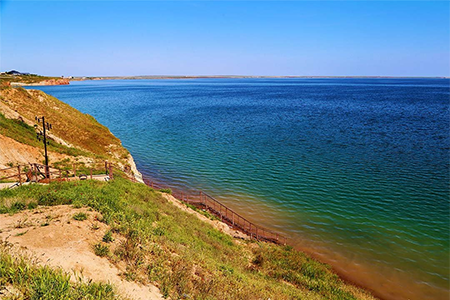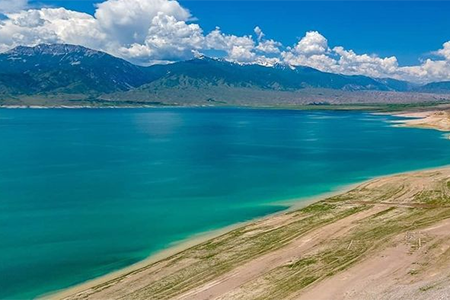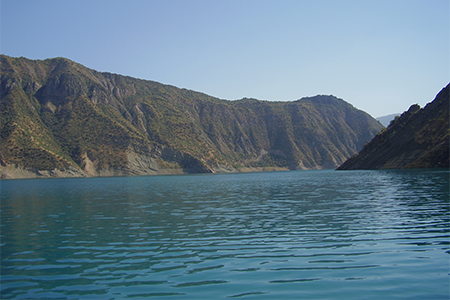
A (water) reservoir is an artificial water body created usually in a river valley by means of water-retaining constructions for accumulation and storage of water to be used in the national economy.
Reservoirs are divided into two types: lake- and river-type ones. Formation of body of water, much differing in their physical properties from the properties of inflow water, is typical of lake-type reservoirs. Streams in these reservoirs occur mainly due to winds. River (in-channel) type reservoirs have elongate shape; streams in them are as a rule of gravity type; according to its characteristics, their water body is close to river water.
The key reservoir parameters are represented by its capacity, water surface area, and amplitude of water level fluctuation during its operation.
Reservoir types
Reservoirs are broken down into the following types:
According to reservoir floor morphology:
• Valley type, the floor of which is represented by a part of a river valley. Its bottom is sloping and its depth increases from the upper part towards the dam:
• in-channel reservoirs: within a channel and low-flood plain;
• floodplain & valley reservoirs: channel, high-flood plain and a part of terraces.
• Basin-type: ponding lakes and reservoirs located in separate lowlands and depressions, bays, limans/coastal lakes, lagoons, and open pits separated from the sea.
According to filling way:
• Impounding type: filled with water of a watercourse on which a given reservoir is built on.
• Off-channel type: filled with water of a closely located watercourse or water body.
According to geographical location:
• Mountain type: located on mountain rivers. This type of reservoirs has head of water.
• Submountain type: head of water is 50-100 m.
• Plain type: usually shallow; head of water is no more than 30 m.
• Coastal type: in sea limans, bays, lagoons, and estuaries; head of water is a few meters.
According to the location in a river basin:
• Upstream type;
• Downstream type.
According to the degree of river flow control:
• over-year storage type;
• seasonal-storage type;
• daily-storage type.
Reservoir for irrigation: reservoir designed for water supply to irrigated areas.
Power reservoir: reservoir designed for hydropower generation.
Multipurpose reservoir: reservoir designed for meeting water demands of several sectors of the national economy. Unlike natural closed water bodies that are not used as reservoirs, in this case there is a set of special terms defining their permissible water storage and rim levels.
Normal water surface (NWS) is an optimum highest reservoir water surface elevation that can be maintained by a head over a long period of time.
Maximum water surface (MWS) or surcharge level is a water surface elevation that exceeds the normal water surface which, when designing a hydrosystem with a known discharge capacity, is determined through the reservoir area and maximum possible water inflow. Exceeding of this level may cause overflow across the dam crest and bring to other emergency situations.
Dead storage level (DSL) or horizon of storage decrease means a water surface elevation aligning with the maximum reservoir emptying. It is defined taking into account reservoir silting conditions, a water level required for fish hibernation, providing environmental conditions, technological features of retaining works, and characteristics of water inflow to the water body.
Dead/inactive storage capacity refers to a reservoir water capacity below the storage decrease horizon (DSL) mark.
Active/live storage capacity refers is a part of reservoir water capacity between optimum highest reservoir water surface elevations (NWS) and storage decrease horizon (DSL).
Surcharge storage (flood-control storage capacity) or regulating storage is a part of reservoir water capacity between MWS and NWS elevations designed to reduce maximum discharge through hydrosystem during spring flood and rainfall flood.
Storage or total storage capacity means the sum of the dead/inactive and live/active capacities.
Flow control implies the process of flow redistribution by a reservoir in order to meet the requirements of the multipurpose water-resources scheme (power engineering, water supply, irrigation, navigation, flood prevention, fishery, etc.). River flow is accumulated in the reservoir during the periods when natural afflux exceeds water requirement and used during the periods when water requirement exceeds afflux.
River flow accumulation period is called reservoir storage (impoundment); loaded water releasing period is called reservoir drawdown (storage decrease).
They discern between main and special types of flow control (storage).
Main flow control (storage) types include: daily, weekly, annual, and over-year ones.
Daily flow control (daily storage) is meant for providing irregular water discharge through hydropower plant (HPP) units subject to the requirements of daily fluctuations of power system load with a relatively constant daily water inflow. At daily flow control, control cycle lasts one day; and by the end of the cycle the upstream water line will fall back to the initial position – DSL. The downstream water line will correspond with the quantity of inflow to the downstream.
Owing to daily flow control, excess flow is accumulated at the upstream side at low load at the hydropower plant, and it is released at higher load. If the reservoir capacity allows accumulating all excess flow, all of this excess flow is used for increasing the HPP capacity in comparison with the capacity of a HPP that uses natural water flow only.
Daily flow control allows extending participation of hydropower plants in covering peak loads and ensuring appropriate uniform operation mode of thermal and nuclear power plants.
It should be noted that HPP operation mode with higher capacity does not result in rise in power generation. By contrast, if a HPP operated without controlling by using natural water flow, its output would be higher.
Sometimes non-energy beneficiaries (navigation, fishery, downstream water diversion, etc.) of the multi-purpose hydrosystem apply restrictions on HPP operation daily control mode.
Weekly flow control (weekly storage) provides uneven water use by HPP units for a week in accordance with the standards for weekly fluctuation of the power system load. At the weekend, load in the power system decreases. During this period HPP can reduce its output, and surplus water obtained in this case can be accumulated in the reservoir. On weekdays, HPP can raise its output by releasing the water accumulated in its reservoirs.
At weekly flow control, HPP operation mode with increased output as a rule is not attended by rise in generation of electric power. Electric power output can increase only if idle water discharge is reduced. Also restrictions can be imposed on the weekly control mode by non-energetic parties of the water utilization system.
Annual flow control (annual storage) allows redistribute water flow in the course of the year according to the needs of the energy system and water users. Control cycle comes to one year. The reservoir is filled with water in high-water years and emptied in low-water years. To carry out annual control, the reservoir capacity should be 5-10% of the annual average flow at partial (seasonal) and 40-60% at full annual control.
The annual-flow-control reservoir allows also performing daily and weekly control.
Over-year flow control (over-year storage) is for increasing HPP discharge and electric power output in low-eater years by using the flow accumulated during high-water years. With over-year control, a reservoir is filled for a series of high-water years and discharged during low-water years.
Over-year control is characterized by variable length of the control cycle. With over-year control, it is possible to raise the firm capacity of the hydropower plant and electric power output due to reduction or elimination of idle water discharge.
There are the following special types of flow control:
Compensating control is performed by an upstream reservoir of a hydropower plants cascade in order to compensate nonuniformity of the inflow from an intermediate catchment area between the reservoirs and HPP sites. Compensating control can be carried out by hydropower plants located on different watercourses but connected by a single power system.
Re-regulation of water flow coming from an upper hydropower plant allows making the water flow even.
Flood and high-water routing is made by means of a reservoir for the purpose of holding back flood peak and lowering water overflowing on a river site down the reservoir.
Emergency operation of a HPP reservoir provides for its drawdown in case of a failure in the electric power system. In this event the HPP takes additional load until the failure is eliminated. After the power system failure is eliminated, the drawdown volume is restored by reducing the HPP load or due to nearest flood.
In the HPP designing and operation practice, calculation of annual and over-year flows is carried out as a rule according to the reservoir operating curve representing the dependence of water discharge and upstream elevation (or water volume in the reservoir) and time.

Reservoirs in Kazakhstan

Reservoirs in Kyrgyzstan

Reservoirs in Tajikistan
Monographs and brochures
Arsenyev, G.S. Framework of reservoirs water resources management [in Russian] (2003) 
Assessment of the Syrdarya river water resources and in-channel balance [in Russian] (2011) 
Davydov, L.K. Fluctuation of the water content of Central Asian rivers [in Russian] (1929) 
Iljin, I.A. Water resources of the Fergana Valley [in Russian] (1959) 
Kuzin, P.S. Cyclical fluctuation of river flows in the northern hemisphere [in Russian] (1970) 
Panov, B.G. Winter regime of USSR rivers [in Russian] (1960) 
Pyanj River Morphology and Flood Protection (2014) 
Rivers and lakes of Tajikistan [in Russian] (2003) 
Stekolnikov, M.A. Water resources of Central Asia and Kazakhstan [in Russian] (1934) 
Shults, V.L. Rivers of Central Asia [in Russian] (1949) 
Shults, V.L. Rivers of Central Asia [in Russian] (1965) 
UNECE- First Assessment of Transboundary Rivers, Lakes and Groundwaters in the UNECE region (2007) 
UNECE- Second Assessment of transboundary rivers, lakes and groundwaters (2011) 
Papers
Alamanov S.K. - Water resources of Kyrgyz Republic and their use (2016) 
Dostai Zh.D., Dostayeva A. Zh. Resources of river runoff of Kazakhstan (2016) 
Mukhabbatov H.M. - Problems of formation and use of water resources of Tajikistan (2016) 
Advisory documents and guidelines
World declaration "Water Storage for Sustainable Development" (Kyoto, 2012) 